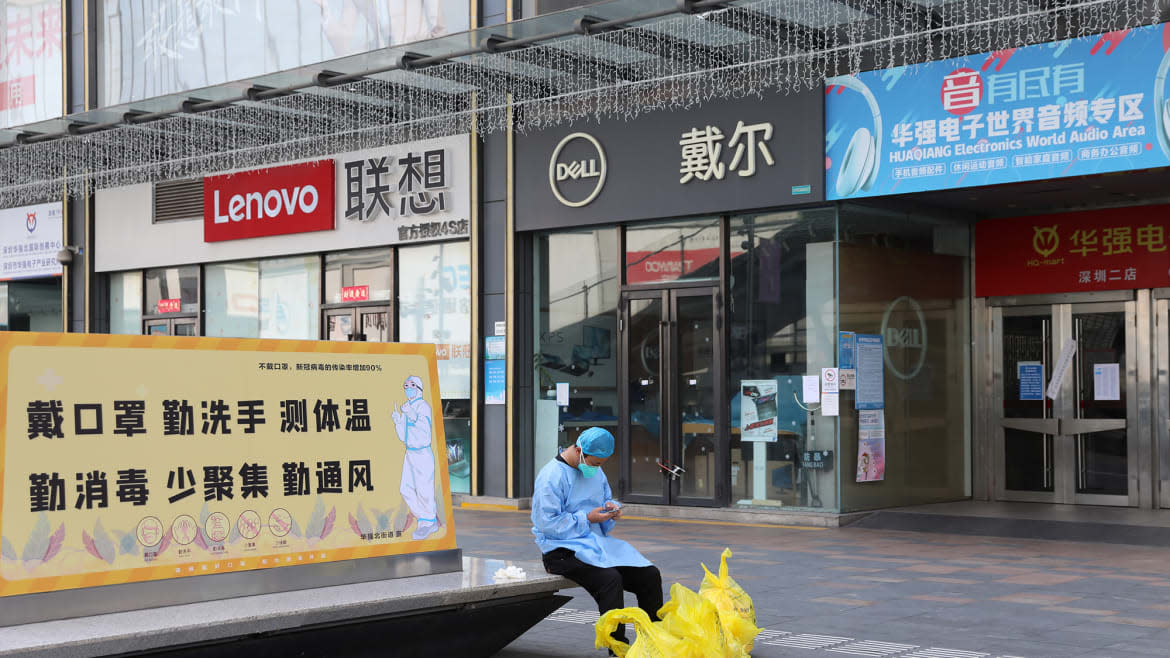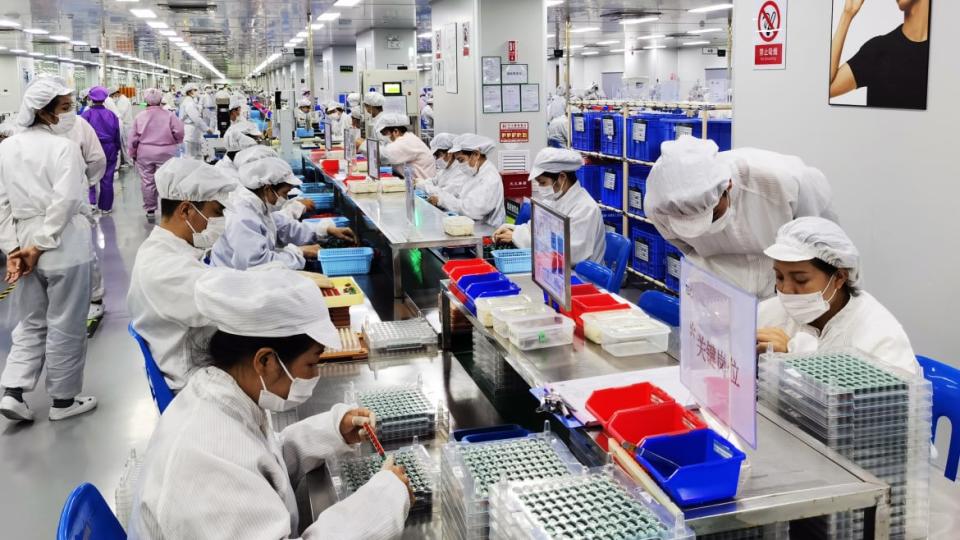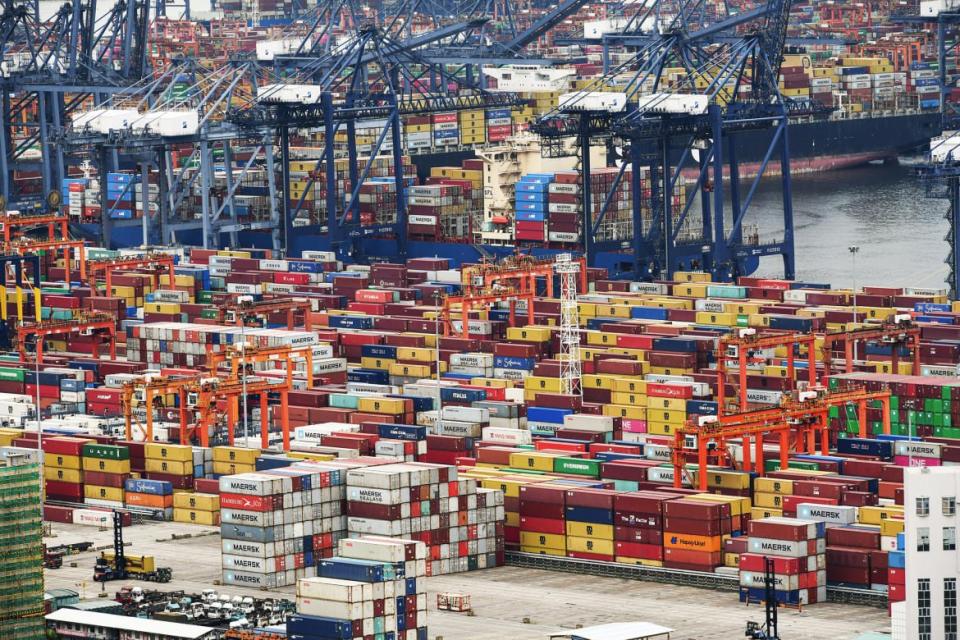We’re Barely Keeping a Lid on Our Next Huge Global Crisis

China has locked down another major city in response to a spike in COVID infections. The entire world could be impacted by this one in a big way.
That’s because Shenzhen, a city of 12.6 million that’s adjacent to Hong Kong in southeastern China, is a major hub for electronics manufacturing. Factories in Shenzhen produce smartphones and tablets as well as computer chips that are vital components in a wide variety of other products, including cars.
The lockdown in Shenzhen, a result of China’s strict—and controversial—“zero-COVID” policy, is a healthy reminder that, despite the lifting of many pandemic-related restrictions in the United States and Europe, the pandemic is not over. “Anyone who thinks we’re past COVID needs to rethink,” Irwin Redlener, the founding director of Columbia University’s National Center for Disaster Preparedness, told The Daily Beast.
How COVID Crept Into This ‘Zero Policy’ Country
It’s also a reminder of the deep wounds the novel coronavirus—and knee-jerk government reactions to the virus—can still inflict, 27 months into the pandemic. The Shenzhen lockdown could further jam up global supply chains that were already stressed by COVID and the war in Ukraine. Experts warn that shortages and price inflation are possible.
The impact on supply chains isn’t inevitable. At least one major manufacturer is already finding work-arounds. And the Chinese government could assist industry by adding flexibility to its zero-COVID rules.
Longer-term, local authorities in Shenzhen could work harder to vaccinate its residents and mitigate future outbreaks. Officials in Beijing could help by authorizing the most effective Western-made vaccines to complement locally made jabs.
All that said, it’s important to not overstate the scale of the Shenzhen outbreak. Daily new infections peaked at just 139 on March 13, the same day local authorities announced a week-long ban on nonessential travel and shuttered many businesses.
The BA.2 subvariant of the dominant Omicron variant appears to be the culprit. BA.2 might be the most transmissible variant of the SARS-CoV-2 pathogen, which has undergone many major mutations over the last two years.
BA.2 is steadily becoming the dominant strain of COVID all over the world, and could drive fresh waves of infections in countries that are just beginning to recover from the previous Omicron wave. Several European countries are reporting upticks in infections. And experts who monitor wastewater in the United States have detected ominous signs of a possible BA.2 wave in coming weeks.

Employees work at RELX e-cigarette factory of Shenzhen Wuxin Technology Co Ltd on Sept. 23, 2021, in Shenzhen, China.
A few hundred cases in a city of nearly 13 million isn’t statistically significant, of course. It’s worth noting that health officials in Shenzhen haven’t yet reported any deaths from the current surge in cases.
The government isn’t taking any chances, however. Authorities weighed the risk of a wider outbreak against the potential economic disruption that could result from a week’s pause in electronics production and decided to prioritize public health.
That’s consistent with China’s long-standing zero-COVID policy, which also prompted major restrictions in Hong Kong during that city’s first major COVID outbreak, last month.
Paul Ananth Tambyah, president of the Asia Pacific Society of Clinical Microbiology and Infection in Singapore, said Chinese leaders are doing what they believe is best for the Chinese people. “I think that the Chinese have seen the devastating impact of partial lockdowns and also the increased numbers of cases stretching health-care systems globally, so they may feel that it is worth giving the zero COVID strategy a chance to prove whether it is indeed possible to nip an outbreak of a virus like this in the bud.”
But economists and supply-chain experts reacted with alarm to the lockdown. “It’s going to be really bad,” Daniel Stanton, a professor of marketing at Bradley University, told Fortune. “When we’re talking about goods coming out of China, it’s not just the finished products we buy directly, but it’s also a lot of parts that are crucial to manufacturing other things that we buy, too.”
The possible impact of a citywide lockdown on supply chains is just one reason that many experts are skeptical of China’s zero-COVID approach to the pandemic. Allowing industries to remain open, with targeted restrictions such as mask and vaccine mandates, might better balance public health and economic health.
The other major reason experts are critical of the zero-COVID strategy is that it doesn’t always work very well. Locking down an entire city as a virus rampages around it protects residents in the short term but also prevents anyone from acquiring natural immunity from past infection. When some sneaky variant finally slips into the city—a virtual inevitability—there’s no natural immunity to slow its spread.
At that point, only further restrictions—or vaccines—can blunt the virus’ impact.
Tragically, however, China’s vaccination campaign has faltered, leaving lockdowns as the only last-ditch defense against rapid viral transmission. Nationwide, more than 80 percent of Chinese residents are fully vaccinated against COVID, but vax rates vary by community.
Just two-thirds of Hong Kong residents are fully vaxxed, for example. And only one in five residents of that city have gone back to their local clinic for a booster dose. Vax rates in neighboring Shenzhen could be similar.

Cargo containers stacked at Yantian port in Shenzhen in China’s southern Guangdong province in 2021.
“Vaccine coverage is also not that high at present in older adults in mainland China,” Ben Cowling, a professor of epidemiology at the University of Hong Kong, told The Daily Beast.
There are hundreds of millions of Chinese who are totally unvaccinated, and hundreds of millions more who should get boosted but haven’t—and are losing their immunity. It’s these unvaxxed and under-vaxxed who are most at risk. Cowling estimated that 85 percent of recent COVID deaths in Hong Kong have been among residents who never got jabbed.
It doesn’t help that the government in Beijing has only authorized Chinese “killed-virus” vaccines, which work by exposing a person to a weakened form of SARS-CoV-2. Those two-dose vaccines, while safe, are widely considered to be less effective than the leading messenger-RNA vaccines developed in the United States and Europe.
It’s unclear why Beijing refuses to authorize Western vaccines. Amesh Adalja, a public health expert at the Johns Hopkins Center for Health Security, ventured a guess. “Early on in the pandemic, China criticized mRNA vaccines, casting doubts on them in favor of their own traditional vaccines,” Adalja told The Daily Beast. “This argues that there is politics, not science, involved.”
In any event, it’s clear that wider access to better vaccines would give local authorities and business leaders more options for addressing surges in cases without having to resort to factory shutdowns.
COVID Finally Spins Out of Control in China as New Variant Takes Hold
“If vaccine coverage could be increased in older adults, I think there would be relatively less justification to continue with the zero-COVID strategy given the social and economic impact of public-health measures,” Cowling said.
That said, some industries have found ways through and around the zero-COVID policy even without greater access to the best jabs. Foxconn, the Taiwanese company that produces Apple’s iPhones and iPads in Shenzhen and other cities, announced on Wednesday that it had resumed production in Shenzhen.
The company exploited a loophole in the citywide ban on nonessential travel. Since many of its workers live on the same campuses where the factories are also located, workers can walk a short distance to work without using trains and buses—which are currently idled—and without violating rules against nonessential travel.
Apple did not immediately respond to a request for comment.
If enough companies find ways to keep factories’ lights on, it’s possible the Shenzhen lockdown will end without additional major disruptions. Store shelves could stay stocked. Inflation might not get worse.
But as long as the novel coronavirus is still with us and China opts to lock down entire cities to slow its spread, there’s still risk of future blows to the global economy as huge countries react to outbreaks without deploying the best tools for suppressing the virus: vaccines. Especially the best mRNA vaccines.
“Increasingly COVID-zero policies are becoming overcome by more contagious variants, more asymptomatic cases, and an unwillingness of the public to comply,” Adlaja told The Daily Beast. “It’s unclear why the Chinese government has been wed to a non-sustainable COVID-zero policy which, with an always destined-to-be-endemic infection, would never be a long-term solution and require authoritarian blunt tools.”
Get the Daily Beast's biggest scoops and scandals delivered right to your inbox. Sign up now.
Stay informed and gain unlimited access to the Daily Beast's unmatched reporting. Subscribe now.

